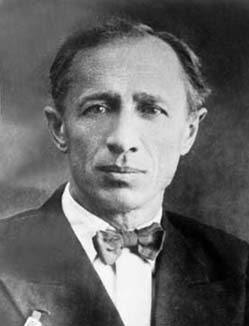
Nikolai Grigorievich Chebotaryov
 المؤلف:
A P Youschkevitch
المؤلف:
A P Youschkevitch
 المصدر:
Biography in Dictionary of Scientific Biography
المصدر:
Biography in Dictionary of Scientific Biography
 الجزء والصفحة:
...
الجزء والصفحة:
...
 25-7-2017
25-7-2017
 909
909
Born: 15 June 1894 in Kamenets-Podolsk, Ukraine
Died: 2 July 1947 in Moscow, USSR

Nikolai Chebotaryov (or Chebotarëv) love of mathematics started at about the age of 15 years. His mother was a strong influence on his education and her lack of knowledge of mathematics seems to have been one of the main reasons that Nikolai went in that direction. Ill health disrupted his education and he spent the winter of 1910-11 in Italy with his mother recovering from pneumonia.
Nikolai entered the University of Kiev in 1912 where he became a student of Grave. He was awarded his degree in 1916, then a master's degree in 1918. At this time he earned a living giving private tuition and teaching in schools.
In 1921 he moved to Odessa to help his parents, and the following year his father died. In this same year, 1922, Nikolai was to prove the theorem for which he is best known, the density theorem, which had been conjectured by Frobenius in a paper written in 1880 but only published in 1896. The density theorem generalised Dirichlet's theorem on primes in an arithmetical progression giving a method used by Artin in 1927 in his reciprocity law, a result considered the main result of class field theory.
By 1924 Nikolai had a permanent job in Moscow but he had been appointed to the post Egorov had been dismissed from for political reasons. It was an unhappy situation and Chebotaryov resigned after a few months. He returned to Odessa and found a poorly paid secretarial post. He did manage to attend a meeting of the German Mathematical Society in Danzig in 1925 where he met Emmy Noether, Hensel and Hasse. After the meeting he met Schur in Berlin then visited Göttingen.
Chebotaryov received his doctorate from the Ukrainian Academy of Sciences with a doctoral thesis based on his 1922 result, the density theorem. He became professor at Kazan University in 1928 having been offered posts at both Kazan and Leningrad. He remained in Kazan all his life.
Chebotaryov worked on the algebra of polynomials, in particular examining the distribution of the zeros. He also studied Galois theory writing a two volume textbook Basic Galois Theory (1934, 1937) and being the moving force in having the first translation of Galois's works into Russian in 1936. Other important work was on Lie groups, and on this topic he wrote the first Russian text Theory of Lie Groups (1940), He also did important work on the inverse Galois problem and the theory of resolvants.
- A P Youschkevitch, Biography in Dictionary of Scientific Biography (New York 1970-1990).
http://www.encyclopedia.com/doc/1G2-2830900875.html
Articles:
- A V Dorodnov, Nikolai Grigorievich Chebotaryov (1894-1947) (Russian), A survey of the history of the N G Chebotaryov Research Institute of Mathematics and Mechanics (Kazan, 1989), 110-118.
- V A Nikiforovskii, Faithful servant of the queen (on the occasion of the centenary of the birth of N G Chebotaryov) (Russian), Vestnik Ross. Akad. Nauk 64 (7) (1994), 634-636.
- Obituary of Nikolai Grigorievich Chebotaryov, Uspekhi matematicheskikh nauk 2 (1947), 68-71.
- P Stevenhagen and H W Lenstra Jr., Chebotarev and his density theorem, The Mathematical Intelligencer 18 (2), 26-37.
 الاكثر قراءة في 1890to1894
الاكثر قراءة في 1890to1894
 اخر الاخبار
اخر الاخبار
اخبار العتبة العباسية المقدسة


